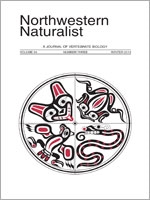We collated 25–30 observations of family groups of Ancient Murrelets (Synthliboramphus antiquus) between 23 May and 25 July 1988–2011 from southwest Vancouver Island, British Columbia, to central Oregon, 450–970 km south of the nearest breeding colony on Haida Gwaii, British Columbia. We proposed 2 hypotheses in explanation of the presence of these groups this far south: (1) rapid long-distance movements by swimming, assisted by strong currents, from colonies on Haida Gwaii (“rapid transport” hypothesis); or (2) undetected local breeding by small numbers of pairs at nearby southern locations (“southern nesting” hypothesis). Far-south groups were generally consistent with relatively long, southern, offshore movements from rearing areas in northern Queen Charlotte Sound, initially with more rapid southward transport by relatively strong (approximately 0.25 m/s) shelf-break currents and strong westerly winds off Vancouver Island in early summer, followed by movement inshore, supporting the rapid transport hypothesis. Nesting was reported at Carroll Island, Washington, in 1924, but apparently by an isolated pair. No evidence of breeding was recorded during seabird colony surveys on the southwest coast of Vancouver Island in 1967–1998 or on the northwest coast of Washington in 1959–1986, although most surveys were conducted June-July, too late for optimal detection of Ancient Murrelets, and some islands on the Washington coast were incompletely examined. Support for the southern nesting hypothesis is lacking but appropriately timed surveys of islands off the northwest Olympic Peninsula are needed to document any limited nesting in this area.
How to translate text using browser tools
22 November 2013
Far-South Ancient Murrelet Family Groups: Rapid Long-Distance Movements or Local Breeding?
Spencer G Sealy
ACCESS THE FULL ARTICLE

Northwestern Naturalist
Vol. 94 • No. 3
Winter 2013
Vol. 94 • No. 3
Winter 2013
Ancient Murrelet
family groups
movements, post-hatching dispersal
rearing areas
surveys
Synthliboramphus antiquus




